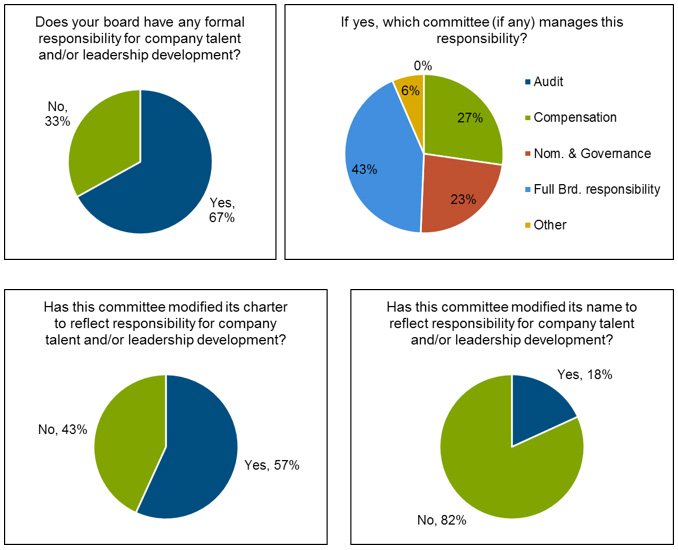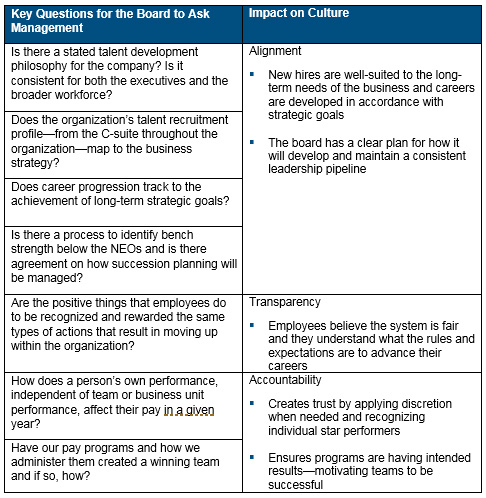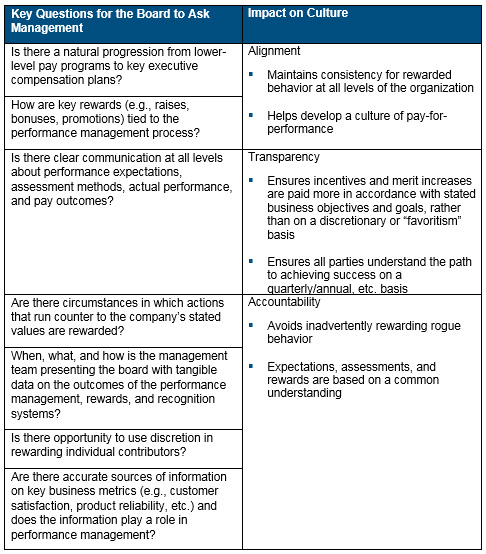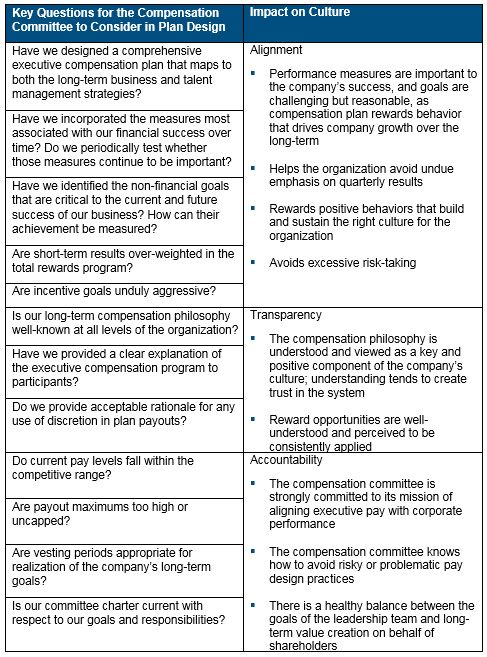
Article | Oct 2017 | NACD Blue Ribbon Commission Report
Supporting Culture Through Compensation, Recognition, and Reward Systems
NACD Blue Ribbon Commissioner David Swinford discusses the role of compensation in the 2017 BRC report “Culture as a Corporate Asset.”
Editor's Note: Pearl Meyer is a strategic content partner for the National Association of Corporate Directors (NACD). Pearl Meyer is an active participant each year on the NACD Blue Ribbon Commission (BRC) and contributor to its annual BRC reports—signature publications that propose new principles and practices to address the most critical boardroom issues. The following article was published as an appendix in the 2017 BRC report Culture as a Corporate Asset.
The role that compensation and incentives play in developing and nurturing a successful corporate culture is an emerging topic on compensation committee and board agendas. Yet in many boardrooms, that conversation is incomplete: directors must step back and think about the broader context first, before diving into the specifics of pay-plan design. While the board’s primary focus is on the management team, it’s important to have a strong sense of the forms of recognition—monetary and otherwise—that matter to and motivate employees, and how those factors influence culture across the entire organization.
Creating a culture of performance begins with the people—hiring, retaining, developing, and rewarding the right talent. It requires empowering that workforce with the opportunities and resources that create strong engagement, as well as the formal and informal recognition programs that help satisfy the needs for achievement and affiliation. It also requires performance management systems or processes that help define and track progress against business goals and career development plans. Under that umbrella, boards can then examine the total reward systems, including compensation programs and other levers that motivate ongoing success.
Directors and members of management want to attract the right talent to the organization to achieve their business goals—talent that is motived by the desire to develop and grow, become more skillful, and earn greater responsibility over time. Given that premise, there are two key questions boards should ask related to the talent development, career progression, and reward systems that can help define a company’s culture. The first is how do people get ahead in the organization? The second, and perhaps more important, is what stalls or derails careers? Are these “rules” (whether written or unwritten) well-known, well-understood, and applied consistently?
The fact is a company can have a carefully designed compensation program, and employees may be able to recite all of the right mantras about corporate values, but if the way one gets ahead is not by their achievements but by political maneuvering, brute force, or excessive risk-taking then that is what will define the true culture. And that climate will be much more powerful than any pay program.
For that reason, boards and compensation committees need a complete picture of the relationship between compensation as it relates to corporate culture: one that includes both financial and non-financial rewards, and that goes beyond the board’s statutorily-defined responsibility for oversight and compensation of CEO and NEO talent. To support a performance-based culture that drives value, the board must have a clear understanding of how talent below the C-suite is developed and rewarded. It must evaluate and determine if this culture supports the company’s long-term business and leadership strategies and if so, must then ensure there is alignment between compensation programs and other forms of recognition and accolades (see sidebar, Rewards and Recognition), not only in the C-suite, but throughout the organization.
With this level of knowledge and oversight of how the company’s talent management is practiced, the board will then be in the best position to determine supporting compensation philosophies and programs. We believe at that point, in order to support culture, the focus should be on the foundational goals of compensation: attract, retain, and motivate—and then reward.
Boards must ask the right questions to understand what an organization is doing to identify the top performers, develop them as future leaders and to ensure that the employees themselves understand what it takes to be successful and how the organization supports their career progress. On a growing number of boards, compensation committees are taking the lead on these important responsibilities for talent strategy oversight.
In the “2016-2017 Director Compensation Report,” a comprehensive research study conducted by the NACD and Pearl Meyer, it was found that among more than 1400 public companies 17 percent have expanded the name and scope of the compensation committee. These names include: Compensation and Leadership Resources Committee, Compensation and Talent Management Committee, Compensation and Leadership Development Committee, and even the Culture and Compensation Committee. Changes to committee names and charters can send a powerful top-down message about the board’s focus on talent development across the organization.
Further, a recent global survey, “Are Boards Creating a Leadership Culture,” conducted by Pearl Meyer and the WomenCorporateDirectors Foundation asked if boards had delegated formal responsibility for leadership and/or talent development to the committee level. Among those who had, 57 percent had taken the additional step to modify the committee’s charter and 18 percent had modified the committee name to reflect this broader scope of oversight.

The 2017 NACD Blue Ribbon Commission has outlined four attributes of a healthy corporate culture: alignment, accountability, transparency, and resiliency. We believe a strong, unified talent development and compensation philosophy that serves a healthy culture also has those characteristics.
Here we align questions for the full board and the compensation committee to review with three of the major corporate elements identified in the graphic Culture as a Unifying Force on page 10 of the report: talent and leadership development, recognition and reward systems, and goals and targets. We believe these are the areas that can be most directly affected by compensation. If pursued, each of these questions can help the board achieve a clearer picture of how compensation can influence the organization’s culture. (See sidebar for examples of cultural “red flags” related to compensation, recognition, and rewards.)
Aligning Compensation with Culture: Index of Questions for Boards and Compensation Committees
Talent Strategy and Leadership Development

Performance Management, Rewards, and Recognition Systems

Goals & Targets

Key Takeaways
- The role of the compensation committee is evolving to encompass greater responsibility and oversight for talent and leadership development and a degree of stewardship of corporate culture.
- Compensation programs that provide the most effective support of corporate culture are created in the context of the organization’s talent management philosophy.
- The most effective compensation programs are also resilient in all aspects—they are sufficiently flexible to accommodate evolving strategy, but are stable enough to achieve long-term objectives.
- The companies known for successful, vibrant, performance-based cultures and the long-term value creation that follows have an organization-wide compensation philosophy that aligns with their integrated business and talent strategies.
- These companies recognize that while incentives are incredibly important, the best compensation programs are holistic and serve to more broadly develop talent, not just push business-based goals.
- The boards that are best supporting their organization’s performance-based culture ensure there is alignment between how talent is managed and rewarded, not only at the executive level, but throughout the company.